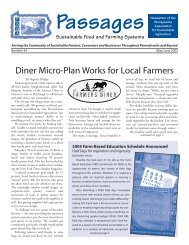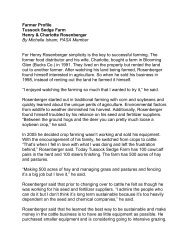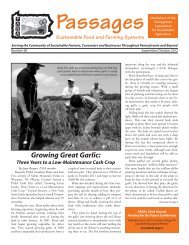Passages Sustainable Food and Farming Systems - PASA
Passages Sustainable Food and Farming Systems - PASA
Passages Sustainable Food and Farming Systems - PASA
You also want an ePaper? Increase the reach of your titles
YUMPU automatically turns print PDFs into web optimized ePapers that Google loves.
Table 3. L<strong>and</strong>, labor <strong>and</strong> energy efficiency of the three LEAFS production systems.<br />
porating all labor inputs for certain crops<br />
for a season as well as yields. The data are<br />
for a mix of crops, some that performed<br />
decently <strong>and</strong> some that did not do as<br />
well. The beans <strong>and</strong> tomatoes were intercropped<br />
as were the leeks <strong>and</strong> onions.<br />
Note that this does not include bed construction<br />
work as that is one-time work,<br />
<strong>and</strong> we did not add in greenhouse labor<br />
when transplants were used, which at the<br />
high end can be another hour of labor to<br />
produce the 400 transplants needed for a<br />
bed of lettuce. These issues aside, the picture<br />
that emerges is not one of labor inefficiency.<br />
Similarly, the yields per unit of<br />
l<strong>and</strong>, extrapolated to an acre, show that a<br />
gross income of $40,000 per acre is feasible,<br />
<strong>and</strong> that is reducing value by half<br />
since processing <strong>and</strong> marketing labor are<br />
not included. Given lower equipment<br />
<strong>and</strong> input costs, this income goes significantly<br />
farther.<br />
Finally, Table 3 displays how the<br />
human-powered treatment performed as<br />
a whole <strong>and</strong> in comparison to the animal<strong>and</strong><br />
machine-powered treatments. With<br />
a record wet spring followed by a tropical<br />
storm <strong>and</strong> flooding in the fall, all systems<br />
struggled. As expected, the human system<br />
performed the best in terms of<br />
energy <strong>and</strong> l<strong>and</strong> efficiency. Energy efficiency<br />
in particular was significantly<br />
higher than in US conventional vegetable<br />
production. Energy return on investment<br />
(EROI) measures the energy produce by<br />
a system relative to the energy needed to<br />
run the system. In modern American<br />
agriculture, EROI values for vegetable<br />
production range from 0.26 (for crops<br />
like spinach) to 1.6 (potatoes) 7 compared<br />
to 5.1 for our system. It is interesting to<br />
note that over a third of the energy inputs<br />
into the human system were in the form<br />
of the energy embodied in seed potatoes<br />
<strong>and</strong> cover crop seeds with potting soil<br />
being another significant input. When<br />
the system requires inputs derived from<br />
mechanical agriculture, there is a significant<br />
loss of energy efficiency.<br />
Conclusion<br />
We are not alone in collecting quantitative<br />
data to demonstrate the value of<br />
human power in farming. I personally<br />
have derived a lot of inspiration from the<br />
work of John Jeavons <strong>and</strong> Ecology<br />
Action. While there is a great need for<br />
further research <strong>and</strong> development of<br />
human powered technologies, the tools<br />
<strong>and</strong> systems that currently exist are sufficient<br />
to produce vegetables successfully<br />
<strong>and</strong> efficiently. And is there really anything<br />
so bad about employing a few more<br />
people in the growing of our food I have<br />
the pleasure of working every day with<br />
young adults ready for just such an<br />
opportunity.<br />
References<br />
1. Farm Manager <strong>and</strong> Research Associate at Green<br />
Mountain College. mulderk@greenmtn.edu,<br />
802-287-2941.<br />
2. Based on data from: Heller <strong>and</strong> Keoleian (2000)<br />
Life Cycle-Based Sustainability Indicators for<br />
Assessment of the U.S. <strong>Food</strong> System, The University<br />
of Michigan — Center for <strong>Sustainable</strong><br />
<strong>Systems</strong>, Ann Arbor, MI, 1-60, CSS00-04.<br />
3. Ibid.<br />
4. Pimentel, D., Hepperly, P., Hanson, J., Douds,<br />
D., <strong>and</strong> R. Seidel. 2005. Environmental, energetic,<br />
<strong>and</strong> economic comparisons of Organic<br />
<strong>and</strong> Conventional farming systems. Bioscience<br />
55(7): 573–582.<br />
5. Please note that I am also an oxen teamster <strong>and</strong><br />
draft animal enthusiast.<br />
6. Jacke, Dave <strong>and</strong> Eric Toensmeier, 2005. Edible<br />
Forest Gardens. Chelsea Green Publishing, VT.<br />
7. Pimentel <strong>and</strong> Pimentel, 2008. <strong>Food</strong>, Energy <strong>and</strong><br />
Society. CRC Press, New York, 2008.<br />
A D V E R T I S E M E N T<br />
Visit <strong>PASA</strong> at<br />
www.pasafarming.org<br />
Join us on Facebook at<br />
pasafarming.org/facebook<br />
Watch us on YouTube at:<br />
www.youtube.com/<br />
pasafarming.org<br />
31







